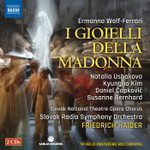|
Back
05/31/2016
Ermanno Wolf-Ferrari: I gioielli della Madonna
Natalia Ushakova (Maliella), Kyungho Kim (Gennaro), Daniel Capkovic (Rafaele), Susanne Bernhard (Carmela), Igor Pasek (Biasco), Peter Maly (Ciccillo), Frantisek Duriac (Rocco), Andrea Vizvári (Stella/Nennelle/Girl), Mária Rychlová (Concetta/Nennelle/Girl), Katarína Flórová (Serena/Nennelle/A Girl), Maksym Kutsenko (Totonno/A Tenor Voice-Act II), Katarína Polakovicová (Flower Girl), Miriam Mat’asová (Water Seller), Michal Zelonka (Vendor of Sacred Wares), Martin Klempár (Ice-Cream Man/Sorbet Seller/Fruit Seller), Daniel Hlásny (Macroni Seller/Pizza Seller), Martin Smolnicky (Blind Man/A Bass Voice-Act II), Patrick Palík (First Morra-Player), Martin Mikus (Second Morra-Player), Vladimir Horváth (First Monk), Milan Kl’ucár (Second Monk), Eva Rampácková (A Young Peasant Girl), Ivan Rychlo (Toy-Balloon Man), Mário Tóth (Young Man), Peter Hricák (Another young man), Daniel Hlásny (Father), Katarina Ofúkaná (A Young Nurse), Attila Kovács, Peter Kruzlia, Ján Keder (Camorristi), Bratislava Boys Choir, Gabriel Rovnák (Choirmaster), Pressburg Singers, Janka Rychlá (Choirmaster), Slovak National Theatre Opera Chorus, Pavol Procházka (Choirmaster), Slovak Radio Symphony Orchestra, Friedrich Haider (Conductor)
A co-producton with Radio and Television Slovakia, Václav Mika (General Director)
Live recording: Great Concert Hall, Bratislava, Slovakia (November 29 & December 2, 2015) – 122’ 51
Naxos # 8.660386-87 – Liner notes in English

   
Despite establishing himself as a successful buffo artist with such notables as Le donne curiose (1903), Il segreto di Susanna (1909) and La vedova scaltra (1931), Ermanno Wolf-Ferrari also explored operas of a veristic nature though they didn’t prove as promising. After an impressive 1911 Berlin opening and subsequent world tour, I gioielli della Madonna was snuffed out until a 1953 Italian grand opening. Flittering with obscurity, the opera was only reignited via the Solvak National Theatre in 2015 that’s beautifully captured on this World Premiere Recording under the Naxos banner.
Verismo, though a waning niche dominated by a Mascagni/Puccini/Leoncavallo tripartite, found Wolf-Ferrari tinkering with new inventions, giving the genre a new shot in the arm: through-composed, psychoanalytical character development, suspenseful plot, richly layered orchestration, majestic choral hymns, use of innovative percussion (i.e. triccheballacche and putipů) and folk instruments (i.e. mandolins, accordions, guitars), folk melodies and multi-tiered leitmotifs.
If the opera’s opening bars and tolling bells (ref: Tosca) seem a bit cacophonous, it isn’t. Wolf-Ferrari knew what he was doing. It sets the tone of what’s to come by using capricious glances into personal lives of every day Neapolitans portrayed by minute vignettes. It almost takes a small Italian village to stage I gioielli, for the demands are enormous: three separate choir companies, full orchestra, not to mention the three dozen roles. Friedrich Haider takes a realistic, practical approach to pacing, and the choral deliveries blend well despite occasional pockets of sudden jerky volumetric intensities. Overall, instrument and choral divisions lay a substantive foundation for the unfolding dramatic tension.
Roughly speaking, I gioielli della Madonna is an expectant love triangle that’s altogether not too dissimilar to Carmen though the topic of religion heavily dominates. Wolf-Ferrari created the plot, and one can’t help think that he was influenced by Bizet’s 1875 opéra comique. The Festival of the Madonna ushers in I gioielli’s ‘Gathering Storm.’ Materialism, namely The Madonna’s jewels, are the causative agent for all three protagonists’ ultimate demise but with variant paths to doom.
Natalia Ushakova’s darkly hued timbre gives her a very respectful edge as Maliella with a June Anderson platinum lining around the high notes. Her most notable aria, “Diceva Cannetella”, radiates charm though more pent up yearnings pervade rather than seductive innuendos as found in the “Habanera”…the linings are similar; the stretta actually turns into a Neapolitan folk song crowned by Ushakova’s impressively sustained high B.
Gennaro’s infatuations (Kyungho Kim) toward his stepsister (Ushakova) are equally strong and fervent with an added dash of empathetic roundedness. Vocal softness and benevolence are highlighted when dialoguing with his reverent mother, Carmela, sung by Susanne Bernhard. Bernhard is blessed with an earthy maternal grounding of compassion and steadfast stability. The melodramatic pičce de résistance “Venedicimi tu” duet is melodically endearing with Bernhard creating an umbrella of empathy and protection which is rendered sublime especially when dignified by Haider’s underpinnings. One can’t help but be persuaded by notions closely found in Carmen’s Micaëla/Don José duet, “Parle-moi de ma mčre.”
The sinister element involves Daniel Capkovic as Rafaele, the commandant de la mafia. Though Mr. Capkovic makes a great attempt, he’s the weakest link: the wobble in his voice elicits tentativeness, so much that it doesn’t convince as being a haughty and arrogant bad guy. A bass voice would have been a better selection for this role. Nonethless, the arietta, “Bacio di lama” possesses perkiness. Inside the Don Giovanni-like "Canzonetta", “Aprila, bella, la fenestrella!”, is a pleasing choral blending with flounce, yet Mr. Capkovic gets drowned out by his own Camorristi.
Sexual tension and lusting really build inside Acts II and III while the three Nennelle (Andrea Vizvári, Mária Rychlová, and Katarína Flórová) splendidly set the scene in the last act, climaxing into a Samson et Dalila bacchanalian like orgiastic dance. Andrea Vizvári’s high tessitura allows her Stella to shine brightly with poignant diction during the debauched number, “Compagni, evviva!” There is a sort of chirpiness akin to Oscar from Un ballo in maschera. Wolf-Ferrari’s modernism creeps inside during the middle of the piece with use of xylophone that glances at Shostakovich. What’s most impressive is Vizvári’s ability to hold her highest notes with confidence and unblemished carries.
It’s a pity I gioielli della Madonna has taken so long for a revisit. But with this marvelous Naxos recording one can hope this will wind its way into standard operatic repertoire. We wait anxiously for the Slovak National Theatre’s DVD. This CD is a jewel for any Wolf-Ferrari fan. Splendid from beginning to end.
Christie Grimstad
|